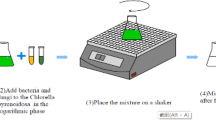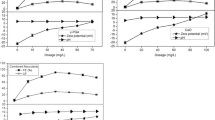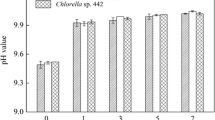Abstract
Microalgal biofuel alternatives have been hindered by their cost and energy intensive production. In the microalgal harvesting process, the intermediate step of flocculation shows potential in drastically reducing the need for costly centrifugation processes. Moringa oleifera seeds, which have been used for water treatment due to their high flocculation potential, low cost and low toxicity, are presented in this paper as strong candidate for flocculating Chlorella vulgaris, a microalgae with high biodiesel production potential. Early results of our group showed a very high flocculation (around 85% of biomass recovery). The aim of this work was to investigate the influence of Moringa oleifera seed flour concentration, sedimentation time and pH on the flocculation efficiency. Cell suspensions treated with Moringa seed flour (1 g L-1) had their flocculation significantly increased with the rise of pH, reaching 89% of flocculation in 120 min at pH 9.2. Sedimentation time of 120 min and a concentration of 0.6 g L-1 proved to be ample for substantial flocculation efficiency. In spite of the need for more research to ensure the economic viability and sustainability of this process, these results corroborate Moringa oleifera seeds as a strong candidate as a bioflocculant for Chlorella vulgaris cells and indicate optimal pH range of its action.






Similar content being viewed by others
References
ABO (2009) – “Executive Summary” Algal Biomass Organization. http://www.algalbiomass.org/resource-center/references/industry-statistics/executive-summary/accessed 24-11-2011
Amaglo KN, Bennett RN, Curto RBL, Rosa EAS, Turco VL, Giuffrida A, Curto AL, Crea F, Timpo GM (2010) Profiling selected phytochemicals and nutrients in different tissues of the multipurpose tree Moringa oleifera L., grown in Ghana. Food Chem 122:1047–1054
Becker E (1995) Microalgae biotechnology and microbiology. Cambridge University Press, Cambridge, pp 158–160
Benemann JR, Oswald WJ (1996) Systems and economic analysis of microalgae ponds for conversion of CO2 to biomass. Final Report to the Pittsburgh Energy Technology Center, Morgantown
Bilanovic D, Shelef G, Sukenik A (1988) Flocculation of microalgae with cationic polymers—effects of medium salinity. Biomass 17:65–76
Divakaran R, Sivasankara Pillai VN (2002) Flocculation of algae using chitosan. J Appl Phycol 14:419–422
Gassenschmidt U, Jany KK, Tauscher B, Niebergall H (1995) Isolation and characterization of a flocculation protein from Moringa oleifera Lam. Biochim Biophys Acta 1243:477–481
Ghebremichael KA, Gunaratna KR, Henriksson H, Brumer H, Dalhammar G (2005) A simple purification and activity assay of the coagulant protein from Moringa oleifera seed. Water Res 39:2338–2344
Guillard RRL, Lorenzen CJ (1972) Yellow-green algae with chlorophyllide-c. J Phycol 8:10–14
Henderson R, Sharp E, Jarvis P, Parsons S, Jefferson B (2006) Identifying the linkage between particle characteristics and understanding coagulation performance. Wat Sci Technol 6:31–38
Jahn SAA (1988) Using Moringa seeds as coagulants in developing countries. J Am Water Works Assoc 80:43–50
Katayon S, Noor MJ, Asma M, Ghani LA, Thamer AM, Azni I, Ahmad J, Khor BC, Suleyman AM (2006) Effects of storage conditions of Moringa oleifera seeds on its performance in coagulation. Bioresour Technol 97:1455–60
Kleiman R, Ashley DA, Brown JH (2008) Comparison of two seed oils used in cosmetics, moringa and marula. Indust Crops Products 28:361–364
Knuckey RM, Brown MR, Robert R, Frampton DMF (2006) Production of micro-algal concentrates by flocculation and their assessment as aquaculture feeds. Aquacult Eng 35:300–313
Lee AK, Lewis DM, Ashman PJ (2009) Microbial flocculation, a potentially low-cost harvesting technique for marine microalgae for the production of biodiesel. J Appl Phycol 21:559–567
Liu JC, Chen YM, Ju Y-H (1999) Separation of algal cells from water by column flotation. Separ Sci Technol 34:2259–2272
Liu D, Li F, Zhang B (2009) Removal of algal blooms in freshwater using magnetic polymer. Water Sci Technol 59:1085–1091
Mani S, Jaya S, Vadivambal R (2007) Optimization of solvent extraction of Moringa (Moringa oleifera) seed kernel oil using response surface methodology. Food Bioprod Process 85:328–335
Mata TM, Martins AA, Caetano NS (2010) Microalgae for biodiesel production and other applications: a review. Ren Sust Energy Rev 14:217–232
Mendieta-Araica B, Spörndly R, Reyes-Sánchez N, Spörndly E (2011) Moringa (Moringa oleifera) leaf meal as a source of protein in locally produced concentrates for dairy cows fed low protein diets in tropical areas. Livestock Sci 137:10–17
Muyibi SA, Evison LM (1995) Moringa oleifera seeds for softening hard water. Water Res 29:1099–1105
Ndabigengesere A, Narasiah KS (1998) Quality of water treated by coagulation using Moringa oleifera seeds. Water Res 32:781–791
Ndabigengesere A, Narasiah KS, Talbot BG (1995) Active agents and mechanism of coagulation of turbid waters using Moringa oleifera. Water Res 29:703–710
Oh HM, Lee SJ, Park MH, Kim HS, Kim HC, Yoon JH, Kwon G, Yoon BD (2001) Harvesting of Chlorella vulgaris using a bioflocculant from Paenibacillus sp. AM49. Biotechnol Lett 23:1229–1234
Okuda T, Baes AU, Nishijima W, Okada M (1999) Improvement of extraction method of coagulation active components from Moringa oleifera seed. Water Res 33:3373–3378
Okuda T, Baes AU, Nishijima W, Okada M (2001) Isolation and characterization of coagulant extracted from Moringa oleifera seed by salt solution. Water Res 35:405–410
Papazi A, Makridis P, Divanach P (2010) Harvesting Chlorella minutissima using cell coagulants. J Appl Phycol 22:349–355
Poelman E, De Pauw N, Jeurissen B (1997) Potential of electrolytic flocculation for recovery of micro-algae. Resour Conserv Recy 19:1–10
Rashid U, Anwar F, Moser BR, Knothe G (2008) Moringa oleifera oil: a possible source of biodiesel. Biores Technol 99:8175–8179
Salim S, Bosma R, Vermuë MH, Wijffels RH (2011) Harvesting of microalgae by bio-flocculation. J Appl Phycol 23:849–855
Sánchez-Martín J, Ghebremichael K, Beltrán-Heredia J (2010) Comparison of single-step and two-step purified coagulants from Moringa oleifera seed for turbidity and DOC removal. Biores Technol 101:6259–6261
Santos AFS, Argolo ACC, Coelho LCBB, Paiva PMG (2005) Detection of water soluble lectin and antioxidant component from Moringa oleifera seeds. Water Res 39:975–980
Schenk PM, Thomas-Hall SR, Stephens E, Marx U, Mussgnug JH, Posten C, Kruse O, Hankamer B (2008) Second generation biofuels: high-efficiency microalgae for biodiesel production. Bioenergy Res 1:20–43
Talreja T (2010) Screening of crude extract of flavonoids of Moringa oleifera against bacteria and fungal pathogen. J Phytol 2:31–35
Vandamme D, Foubert I, Meesschaert B, Muylaert K (2010) Flocculation of microalgae using cationic starch. J Appl Phycol 22:525–530
Wijffels RH, Barbosa MJ (2010) An outlook on microalgal biofuels. Science 13:796–799
Acknowledgments
The authors are grateful to Dr. Gabriel Francisco da Silva from Sergipe Federal University for providing the seeds of Moringa oleifera and to Dr. Armando Vieira from São Carlos Federal University for providing the culture of Chlorella vulgaris.
Author information
Authors and Affiliations
Corresponding author
Rights and permissions
About this article
Cite this article
Teixeira, C.M.L.L., Kirsten, F.V. & Teixeira, P.C.N. Evaluation of Moringa oleifera seed flour as a flocculating agent for potential biodiesel producer microalgae. J Appl Phycol 24, 557–563 (2012). https://doi.org/10.1007/s10811-011-9773-1
Received:
Revised:
Accepted:
Published:
Issue Date:
DOI: https://doi.org/10.1007/s10811-011-9773-1




